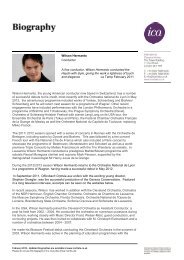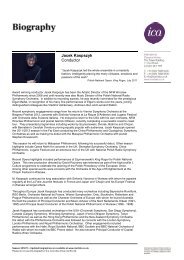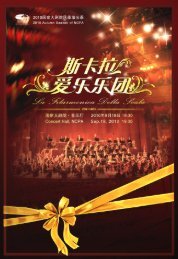to download the DVD booklet. - International Classical Artists
to download the DVD booklet. - International Classical Artists
to download the DVD booklet. - International Classical Artists
Create successful ePaper yourself
Turn your PDF publications into a flip-book with our unique Google optimized e-Paper software.
with <strong>the</strong>ir disgruntled swains. David Blair, who danced <strong>the</strong> role of Captain Belaye at <strong>the</strong> ballet’s 1951<br />
premiere, recreated his performance for <strong>the</strong> 1959 telecast seen on this <strong>DVD</strong>.<br />
For <strong>the</strong> musical setting for The Lady and <strong>the</strong> Fool, Mackerras turned <strong>to</strong> <strong>the</strong> music of Verdi, extracting<br />
less familiar music from fifteen of his operas. He managed <strong>to</strong> fashion a particularly effective score<br />
for <strong>the</strong> somewhat darker mood of this second collaboration with Cranko, who provided both <strong>the</strong><br />
scenario and choreography.<br />
The Lady and <strong>the</strong> Fool premiered in Oxford on 25 February 1954, <strong>the</strong> London premiere taking place at<br />
Sadler’s Wells Theatre just a month later. It did not enjoy <strong>the</strong> immediate initial success of Pineapple<br />
Poll. Cranko’s choreography for <strong>the</strong> corps de ballet in <strong>the</strong> central ballroom scene lacked his usual<br />
inventiveness; he seemed <strong>to</strong> be creatively coasting. And he was not helped by his designer, who had<br />
worked mostly as a painter and had little experience in <strong>the</strong> <strong>the</strong>atre arts. Cranko had <strong>the</strong> opportunity <strong>to</strong><br />
rework <strong>the</strong> ballet for a Covent Garden opening on 9 July 1955 and it was much more tightly focused.<br />
Some of <strong>the</strong> ancillary characters were dropped completely, helping <strong>to</strong> emphasise <strong>the</strong> relationships<br />
among <strong>the</strong> principal protagonists. The décor was also greatly improved, and <strong>the</strong> orchestra was<br />
augmented, resulting in a more luxurious soundscape.<br />
The three main charaters in The Lady and <strong>the</strong> Fool are two itinerant clowns, Moondog and Bootface,<br />
and La Capricciosa, a masked beauty. Moondog and Bootface have fallen asleep on a bench near <strong>the</strong><br />
palace of Signor Midas. La Capricciosa passes <strong>the</strong> clowns on her way <strong>to</strong> <strong>the</strong> palace, where a ball is<br />
being held, and she invites <strong>the</strong>m <strong>to</strong> join her.<br />
At <strong>the</strong> masked ball, <strong>the</strong> clowns entertain <strong>the</strong> guests while La Capricciosa is pursued by three of<br />
Signor Midas’ aris<strong>to</strong>cratic guests, but she rejects <strong>the</strong>m, and when she is finally alone, she removes<br />
her mask as Moondog enters <strong>the</strong> ballroom. He instantly falls in love with her and she with him,<br />
much <strong>to</strong> <strong>the</strong> consternation of her o<strong>the</strong>r sui<strong>to</strong>rs and of Bootface, who has unsuccessfully tried <strong>to</strong><br />
attract some of <strong>the</strong> debutantes at <strong>the</strong> ball. La Capricciosa and Moondog leave <strong>to</strong>ge<strong>the</strong>r, but return <strong>to</strong><br />
take Bootface with <strong>the</strong>m. In <strong>the</strong> final scene, <strong>the</strong> trio returns <strong>to</strong> <strong>the</strong> bench where <strong>the</strong> clowns were<br />
sleeping earlier and curls up <strong>to</strong> sleep as <strong>the</strong> curtain falls.<br />
Both Pineapple Poll and The Lady and <strong>the</strong> Fool remained in <strong>the</strong> reper<strong>to</strong>ire of <strong>the</strong> Sadler’s Wells Ballet<br />
with sporadic revivals and with productions in o<strong>the</strong>r companies, as well. When <strong>the</strong> company, by <strong>the</strong>n<br />
<strong>the</strong> Royal Ballet, <strong>to</strong>ured Russia, The Lady and <strong>the</strong> Fool was its most popular offering. Quite possibly,<br />
<strong>the</strong> plight of <strong>the</strong> homeless Moondog and Bootface and <strong>the</strong>ir ultimate embrace by <strong>the</strong> seemingly<br />
unattainable La Capricciosa struck a sympa<strong>the</strong>tic chord with <strong>the</strong> Russian audiences.<br />
Cranko’s subsequent work for his Suttgart company embraced a much larger vision than <strong>the</strong>se<br />
delightful diversions he created for London, and he was given all <strong>the</strong> resources he needed <strong>to</strong> realise<br />
it. He was just forty-five when he died on a transatlantic flight following a wildly successful New York<br />
engagement by his company. One can only conjecture what might have been had death not so<br />
rudely intervened.<br />
Ernie Gilbert<br />
PINEAPPLE POLL ET THE LADY AND THE FOOL<br />
John Cranko (1927–1973) était un maître du ballet narratif. Bien que son travail puisse être<br />
considéré comme anachronique à une époque où le néoclassicisme s’était imposé dans le monde<br />
de la danse avec la domination de George Balanchine, les drames dansés de Cranko ont connu un<br />
succès durable. Ce n’est pas simplement que ses meilleurs ballets étaient fondés sur certaines des<br />
plus grandes œuvres de Shakespeare et de Pouchkine; l’imagination fertile de Cranko donna le<br />
jour à des épisodes chorégraphiques d’un effet saisissant, jetant une lumière nouvelle sur des<br />
récits connus. L’excellente biographie de Cranko signée par John Percival est très justement<br />
intitulée Theatre in My Blood ! (Théâtre dans mon sang). La théâtralité est en effet l’essence du<br />
génie de Cranko.<br />
Les chefs-d’œuvre de Cranko qui remplissent <strong>to</strong>ute une soirée, Roméo et Juliette (1962), Onéguine<br />
(1965) et La Mégère apprivoisée (1969), confirmaient que sa compagnie, le Ballet de Stuttgart, était<br />
un acteur majeur sur la scène chorégraphique mondiale. Le fait que ces œuvres soient ensuite<br />
entrées au réper<strong>to</strong>ire de bon nombre des plus grandes compagnies de ballet au monde confirme<br />
l’universalité de leur valeur. Et même si elles étaient au départ conçues sur mesure pour les talents<br />
spécifiques des grands danseurs de Cranko à Stuttgart, elles ont trouvé d’éloquents interprètes<br />
ailleurs. Leur réussite tient à la danse, et non seulement aux danseurs.<br />
Avant que Cranko ne prenne la direction de sa troupe à Stuttgart, ses activités étaient confinées à<br />
Londres. Né en Afrique du Sud, il s’établit dans la capitale britannique à l’âge de dix-huit ans et<br />
rejoignit peu de temps après le Sadler’s Wells Ballet. Toutefois, lui-même et les directeurs de la<br />
compagnie comprirent bientôt clairement que ce n’était pas en tant que danseur qu’il était précieux<br />
pour la compagnie, mais en tant que chorégraphe. Son premier grand succès fut la comédie<br />
délirante Pineapple Poll, créée le 13 mars 1951 dans le cadre d’une soirée entièrement consacrée à<br />
Cranko – événement de taille pour le jeune chorégraphe!<br />
Pineapple Poll fut la première collaboration entre Cranko et Charles Mackerras, alors chef assistant<br />
du Sadler’s Wells Opera. Mackerras avait le sentiment que la musique de Sir Arthur Sullivan, qui<br />
venait de <strong>to</strong>mber dans le domaine public, conviendrait admirablement à une partition de ballet.<br />
Il avait dirigé d’innombrables représentations d’opérettes de Gilbert et Sullivan et, à partir de<br />
près d’une douzaine d’entre elles, assembla un charmant cadre musical pour l’exubérant ballet<br />
de Cranko.<br />
Les principaux personnages de Pineapple Poll sont Pineapple Poll, une marchande de fleurs, Jasper,<br />
le “garçon” de la taverne locale, et le fringant capitaine Belaye de H.M.S. Hot Cross Bun, qui vient<br />
d’accoster à Portsmouth. Toutes les jeunes filles de la ville se disputent l’attention du capitaine<br />
Belaye, y compris Pineapple Poll – au grand désarroi de Jasper, très épris d’elle. Mais c’est<br />
Blanche, une beauté locale chaperonnée par sa tante, Mrs Dimple, qui a capté le regard de Belaye.<br />
Les jeunes filles de Portsmouth entichées du capitaine recourent à d’extravagants stratagèmes pour<br />
8<br />
9

















